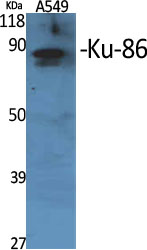LOX-1-FC recombinant protein
- Catalog No.:YD3001
- Reactivity:Human;
- Purity:
- >90% as determined by SDS-PAGE
- Protein Name:
- Oxidized low-density lipoprotein receptor 1 (Ox-LDL receptor 1) (C-type lectin domain family 8 member A) (Lectin-like oxidized LDL receptor 1) (LOX-1) (Lectin-like oxLDL receptor 1) (hLOX-1) (Lectin-t
- Sequence:
- Amino acid:58-273,with FC tag.
- Formulation:
- Phosphate-buffered solution
- Storage Stability:
- -15°C to -25°C/1 year(Avoid freeze / thaw cycles)
- Other Name:
- Oxidized low-density lipoprotein receptor 1 ;Ox-LDL receptor 1;C-type lectin domain family 8 member A;Lectin-like oxidized LDL receptor 1;LOX-1;Lectin-like oxLDL receptor 1;hLOX-1;Lectin-type oxidized LDL receptor 1; ;OLR1;CLEC8A;LOX1;
- Function:
- Receptor that mediates the recognition, internalization and degradation of oxidatively modified low density lipoprotein (oxLDL) by vascular endothelial cells. OxLDL is a marker of atherosclerosis that induces vascular endothelial cell activation and dysfunction, resulting in pro-inflammatory responses, pro-oxidative conditions and apoptosis. Its association with oxLDL induces the activation of NF-kappa-B through an increased production of intracellular reactive oxygen and a variety of pro-atherogenic cellular responses including a reduction of nitric oxide (NO) release, monocyte adhesion and apoptosis. In addition to binding oxLDL, it acts as a receptor for the HSP70 protein involved in antigen cross-presentation to naive T-cells in dendritic cells, thereby participating in cell-mediated antigen cross-presentation. Also involved in inflammatory process, by acting as a leukocyte-adhesion
- Subcellular Location:
- Cell membrane; Lipid-anchor. Cell membrane; Single-pass type II membrane protein. Membrane raft. Secreted. Note=A secreted form also exists. Localization to membrane rafts requires palmitoylation.
- Expression:
- Expressed at high level in endothelial cells and vascular-rich organs such as placenta, lung, liver and brain, aortic intima, bone marrow, spinal cord and substantia nigra. Also expressed at the surface of dendritic cells. Widely expressed at intermediate and low level.

